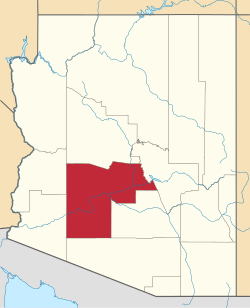- The Old Rittenhouse Elementary School, located on the S.E. corner of Ellsworth and Queen Creek roads was built in 1925. Used as a school through 1982, this building now houses the San Tan Historical Society. Listed in the National Register of Historic Places in 1998. Reference 98000053
- Ruins of the Desert Wells Stage Stop. Located just north of Chandler Heights Road on the east side of Sossaman Road, this site was a small spur stop for the Arizona Stage Company, founded in 1868. The stop provided water, shade, and protection for stages from Florence via Olberg and on to Mesa. Listed as historical by the San Tan Historical Society.
- 1900s Railroad Water Tank on Rittenhouse Road.
Queen Creek, Arizona | |
|---|---|
 Queen Creek Town Hall | |
 Location in Maricopa and Pinal counties | |
| Coordinates: 33°14′55″N111°38′03″W / 33.24861°N 111.63417°W | |
| Country | United States |
| State | Arizona |
| Counties | Maricopa, Pinal |
| Incorporated | September 5, 1989 |
| Government | |
| • Mayor | Julia Wheatley [1] |
| Area | |
• Total | 42.130 sq mi (109.116 km2) |
| • Land | 42.102 sq mi (109.043 km2) |
| • Water | 0.028 sq mi (0.073 km2) |
| Elevation | 1,417 ft (432 m) |
| Population (2024) [4] | |
• Total | 83,700 |
| 87,006 | |
| • Rank | US: 483th AZ: 16th |
| • Density | 1,688/sq mi (651.6/km2) |
| Time zone | UTC–7 (Mountain (MST) (no DST)) |
| ZIP Codes | 85140, 85142, 84143, 85144 |
| Area code | 480 |
| FIPS code | 04-58150 |
| GNIS feature ID | 2412518 [3] |
| Sales tax | 8.55% [6] |
| Website | queencreekaz.gov |
Queen Creek is a town in Maricopa and Pinal counties in Arizona, United States. The population was 59,519 at the 2020 census, and is at a population of 83,700 as of 2024. [4] It is a suburb of Phoenix, located in the far southeast area of the Phoenix Metropolitan Area.






